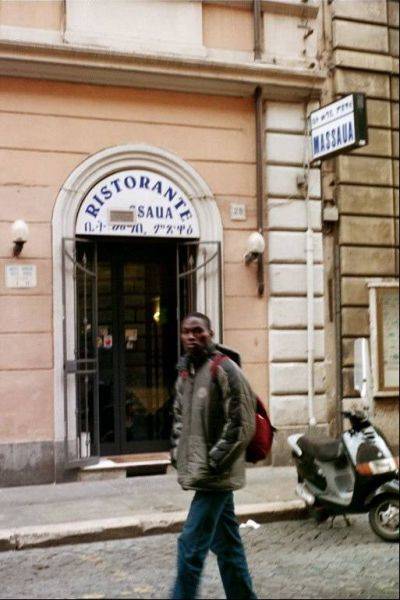Bensonhurst and Italia: Racism and Razzismo (Part I)
The Racism/Razzismo label is a tricky issue for italians and Italian Americans alike. A few days ago I participated in a conference on "The Status of Interpretation in Italian American Studies." It was the first symposium of the Forum on Italian Criticism established by the Center for Italian Studies at the State University of New York at Stony Brook. An elite collection of scholars spoke, and as is typical with "Italian" meetings, the the audience participation was as enlightening as the presentations.
One testy issue was attaching the term "racist" to the unfortunate killings, beatings, and other assaults on Afro-Italians, and African immigrants as well as attacks on the homes and property of other stranieri, immigrati, clandestini, extracomunitari, eccetera in Italy. An Italian scholar argued that although some of aspects of the acts, like the use of the term "negro" which preceded the beating death in Milano of an alleged petty thief, might have involved racism, using the term "racist" to describe the act was inappropriate.
His discomfort reminded me of the way working-class Italian-American residents of Bensonhurst tried to explain the murder of Yusuf Hawkins, a young Black man who was murdered by a racist mob on their generally quiet and safe streets in 1989. They also felt the murder was unfortunate but certainly not really "racist". Because of the unfortunate parallels between the growing number of allegedly racist attacks in Italy and continuing covert and overt racism in the United States (especially in regard to the Presidential candidacy of Barack Obama), I will present, in three parts, what I wrote in 1989 about the murder of Yusuf Hawkins. This was an event that sullied the reputation of all Italian Americans. I hope that this series cautions all Italians that they too will be seen by the rest of the world collectively as racists because of the acts of a few.
Part I: Bensonhurst, Brooklyn: Italian-American Victimizers and Victims* was published in 1994 in Voices in Italian Americana.
This paper addresses a number of interrelated issues that have emanated from a series of recent tragic “incidents” that have seriously affected the reality, as well as the image, of Italian Americans. The incidents in question were racially motivated assaults and homicides involving Italian Americans or taking place in neighborhoods described as Italian American. These events have received national as well as international media attention. As a result, the three New York neighborhoods; Gravesend’s Avenue X, Howard Beach, and Bensonhurst have been added to the American urban lexicon of infamous places. In these places three black men; Willie Turks (1982), Michael Griffith (1987) and Yusuf Hawkins (1989), were murdered. A central issue addressed here, and seldom discussed elsewhere, is the role played by Italian-American professionals, and those others who study the Italian community, in helping to present to the general public an accurate picture of the various and diverse segments of the Italian-American population. This must be done without reservation and without apology even when the situation, such as instances of intergroup violence, is distasteful.
Equally important to Italians in America is the issue of ethnic defamation. Defamation, however, cannot be effectively dealt with by mere denial; it must be countered with accurate information. Italians in the United States, as elsewhere in the world, have long suffered from a “bad press.” Works such as Salvatore J. La Gumina’s WOP: A Documentary History of Anti-Italian Discrimination in the United States, for example, have clearly demonstrated this symbolic historical reality on the American scene through an examination of text and illustrations concerning Italians in newspapers and other periodical literature. As I had noted in a previously published article on “The Italian American Community: an Essay on Multiple Social Realities,” the negative images produced and disseminated in the various media have persisted despite the presentations and protestations of more or less objective scholars and ethnic-group spokespersons. The three organizations, which have been most active in the area of combating the negative stereotyping of Italian Americans in recent years, have been the American Italian Historical Association, the National Italian American Foundation, and the Commission for Social Justice of the Order Sons of Italy in America. Groups such as these have been exceptionally forceful regarding the “criminal” and “mafia” stereotyping of Italian Americans. Since the liberal social activism of the 1960s, two new, and perhaps even more dangerous, negative images have been added to the historical repertoire of nocuous and innocuous organ grinders, old ladies in black dresses, birds of passage, stiletto wielders, mindless Madonnas, mafia dons, wise guys, spaghetti sauce makers and disco dancers who have been held up as images of Italian Americans; that of social “reactionary” and racial “bigot.”
A major threat presented by this contemporary stereotype is the potential that the Italian-American community can be easily scapegoated for the economic and other failures of low-income minority groups in the United States making inter-group cooperation even more difficult. On the political side, this would also make it less likely for Italian-Americans leaders to serve as inter-ethnic bridges in American politics as they have frequently done in the past. One could note in this vein for example, Vito Marcantonio, Fiorello LaGuardia and Mario Cuomo and many others, who promoted better inter-group relations. The reputation of Italian Americans and Italian-American neighborhood groups as vocal opponents of racial integration is not undeserved. The question in this essay is not whether some Italian Americans are biased but why they are perceived as being so much more so than other ethnic groups, and what can and should be done about it. It is not merely that the reputation of Italians in America is at stake; the establishment of better inter-group relations is an especially critical problem in large American cities and their near suburbs today. Not since the turbulent 1950s have cities been faced with such rapid demographic transitions.
The United States in the 1990s is experiencing a new, almost tidal, wave of Hispanic, Black and Asian immigration that is virtually swamping older urban areas, such as the New York-New Jersey Metropolitan Area. Given that working class Italian-American populations occupy residential territories which are directly in the path of minority group expansion, they are also the most likely to experience inter-racial and inter-ethnic conflict on a local level between themselves and other ethnic minorities. As noted by Robert C. Freeman in his article on “The Development and Maintenance of New York City’s Italian-American Neighborhoods,” the cultural propensity of Italians toward residential stability has resulted in their being, in many cases, the last white ethnic group in changing urban communities. The recent history of bias-related criminal incidents in Brooklyn, New York presents glaring evidence of the reality of inter-group fear, hostility and ever-present potential for violence. These incidents have been by no means limited to those between Italian Americans and others.
No ethnic group, either as victim or perpetrator, has been immune to this plague. In researching New York City newspapers for stories concerning inter-ethnic violence, not involving Italian Americans, over the past two years the following polarities of victim and perpetrator represent only a partial listing: Black-Korean, Asian-Black, Black-Jewish, Jewish-Black, Jewish-Hispanic, Hispanic-Jewish, Indian-White as well as intra-Caribbean, Asian, and Hispanic. Despite the participation of a broad spectrum of ethnic groups in the troubling reality of inter-ethnic violence, the Italian-American community has received the greatest press attention. Why has this happened? I believe that a major reason for the focus upon Italian Americans as epitomizing racial bigotry among white Americans is the reluctance of most Italian-American organizations and their leaders to honestly address the problem of racial and ethnic bias. In most cases Italian-American spokespersons have tended to deny the extent or degree of the problem or to make defensive statements when bias incidents in the community occur. This has resulted in an even greater focus on the community because it projects an appearance of lack of remorse or sympathy for victims of bias-related violence.
The following are two articles (to be presented in Parts II and III in i-italy) written by the author following the most highly publicized interracial homicide involving Italian Americans or a neighborhood identified as Italian American. They were published in The Brooklyn Free Press, a bi-monthly local newspaper. Being a professional sociologist, I have studied community problems in many different ethnic contexts. These pieces combine a direct, no excuses approach to the incident with some historical and sociological “understanding” of the Italian-American experience. Rather than excuses, influenced by ethnic pride or shame, they offer an alternative and more effective approach to explaining the problem of inter-ethnic violence to the public. A new approach is needed because it is certain that intergroup violence will continue in urban America and elsewhere. As an American of Italian descent, I believe that the Italian-American scholarly and professional community has an “ethnical” responsibility to offer its sensitive and informed opinions and advice in the service of better intergroup relations in an increasingly volatile urban environment. As the reader will easily notice, the first article was written with a great deal of anger. It was composed immediately after the slaying of a black teenager in a predominately first and second-generation working-class Italian-American section of Bensonhurst, Brooklyn. The stereotypical “Italianness” of the area was highlighted in all the major press accounts of the homicide. Although I was consulted as an “expert” by many reporters and widely quoted in a number of the resulting stories, my own reaction to the slaying was focused on the political and economic, not the ethnic aspects of the tragedy. Simply stated, the various media were doing a story about a homicide of an African American by Italian Americans.
*Introduction to my paper: “Bensonhurst, Brooklyn: Italian American Victimizers and Victims.” Voices in Italian Americana. Vol. 5, No. 2, (Fall), 1994:43-53.







































i-Italy
Facebook
Google+
This work may not be reproduced, in whole or in part, without prior written permission.
Questo lavoro non può essere riprodotto, in tutto o in parte, senza permesso scritto.